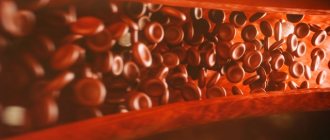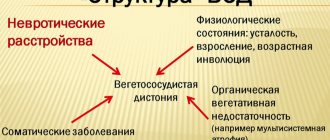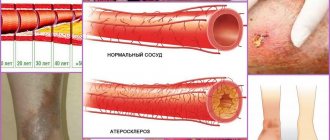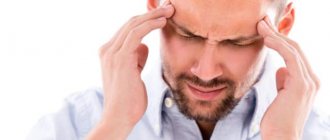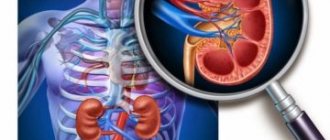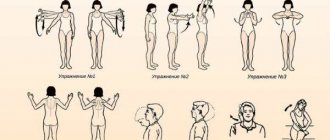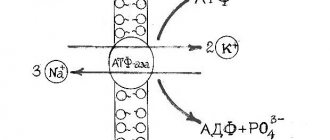Causes of VSD
VSD is a disease that develops as a result of disruption of the autonomic nervous system. This system regulates metabolic processes and maintains the constancy of the internal environment, and also helps the body adapt to changes in external factors.
As a result of many predisposing facts, a malfunction occurs in its work, accompanied by severe symptoms.
Vegetative-vascular dystonia: symptoms and treatment
The most likely causes of the disorder will be the following:
- Atherosclerotic changes in blood vessels, provoking the deposition of cholesterol plaques on their walls and circulatory disorders.
- Vascular diseases accompanied by impaired tone and changes in pressure inside the bloodstream.
- Cardiac disorders, which in most cases are accompanied by tachycardia and other disorders.
- Coronary heart disease, severe heart failure.
- Obesity, a metabolic disorder that increases the load on all internal organs.
- Thyroid diseases.
- Neurological disorders accompanied by disorders of the brain and spinal cord.
- Tendency to allergic manifestations.
- Professional activities associated with regular contact with harmful substances, toxins and poisons.
- Diabetes mellitus type 1.
- Vitamin deficiency, unhealthy diet, causing a lack of necessary components.
Such factors can cause the development of VSD. They not only cause disease, but also aggravate the patient's condition.
Treatment
If dermographism is red, but fits into the concept of the physiological norm, then no treatment is required. For patients with hyperactivity of the parasympathetic nervous system, anxiety and emotional lability, sedatives, anxiolytics, and “minor” tranquilizers are recommended. It is necessary to lead a healthy lifestyle, normalize nutrition, and avoid stress. Contrast showers, swimming and sufficient physical activity also help normalize the tone of the vascular system.
With pathological dermographism, it is not the skin manifestations that should be treated, but the primary disease. Given the polymorphism of probable causes, therapeutic tactics may be different. But its essence comes down to eliminating disorders that provoke an imbalance of neurovascular regulation. Adequate treatment will always lead to the elimination of symptoms.
Red dermographism can be caused normally, but it acquires much greater importance in the diagnosis of pathological conditions. He talks about the activity of the parasympathetic nervous system and reduced vascular tone, which happens in various situations. And only those who have cured the underlying disease always note the disappearance of excessive skin reactions.
Risk factors
Vegetative-vascular dystonia (symptoms in adults can manifest themselves differently) is considered a common disease, as it is diagnosed even in adolescents and young adults. The risk group includes patients who are overweight and have a weakened immune system, bad habits, hypertension, and alcoholism.
In addition, one of the factors is poor ecology, which provokes changes in the functioning of internal organs and systems. Patients with a hereditary predisposition to the disease are also at risk. They develop the disease several times more often than those who do not have relatives suffering from VSD.
Women of reproductive age are at risk because they often experience hormonal changes that provoke the disease. Experts believe that it is the imbalance of hormones that in most cases leads to the appearance of symptoms of the disorder. This also explains why the signs appear more often in women.
Treatment of dermographism
The need for treatment of dermographism arises only in the case of intense skin manifestations accompanied by itching. To relieve them, the patient is prescribed antihistamines.
If dermographism is accompanied by severe itching, the patient intensively scratches the skin, which is fraught with infection and the development of an inflammatory process.
Patients with urticarial dermographism are prescribed ketotifen therapy for 2-3 months. Against this background, the membranes of mast cells are stabilized, as a result of which abnormal skin reactions in response to irritation occur much less frequently.
Antihistamines are prescribed for dermographism, accompanied by intense skin manifestations and itching
In some cases, ultraviolet irradiation of the skin has a good, but short-term effect.
Lotions made from infusions of medicinal plants (oak bark, chamomile, sage) can reduce swelling and itching.
By identifying and treating provoking diseases, long-term remission of dermographism can be achieved, and in some cases, complete recovery.
General symptoms
Dystonia manifests itself differently in each patient. But doctors identify several common symptoms that are observed in all patients with varying degrees of intensity.
Sleep problems
Sleep disorders are observed in all patients with dystonia. However, they can manifest themselves in the form of insomnia or constant drowsiness. Such manifestations are associated with a disruption in the functioning of the autonomic system, which leads to changes in biological factors "class="aligncenter" width="700″ height="465″[/img]
A patient with insomnia is unable to relax, so sleep is always short-lived and restless.
This leads to daytime sleepiness, attention disorder, memory impairment and decreased performance. With a long absence of normal sleep, psycho-emotional disorders develop; the patient’s nervous system cannot cope with the load, which leads to breakdowns.
Emotional instability
In most cases, this manifestation is also the result of insomnia. The patient's body is exhausted and weakened. A person constantly feels tired, so his mood suddenly and dramatically changes. After a short rest, the patient is peaceful and cheerful. After a while he becomes sad or even aggressive.
Such changes frighten the patient himself, but he is not able to control himself.
Change in skin color
Vegetative-vascular dystonia (symptoms in adults often appear suddenly) in most cases is accompanied by a change in skin color. The symptom is associated with a violation of vascular tone, which leads to a rapid flow of blood to the skin and the same rapid outflow.
In the first case, redness appears on the skin or all the integuments become red; in the second, the skin turns pale and is cold to the touch. It is worth noting that such changes are observed during emotional arousal or when performing heavy physical work.
Respiratory disorders
Shortness of breath or suffocation during VSD is associated with impaired innervation of the respiratory system. Usually the patient does not have symptoms of any diseases, but under stress, overwork, or doing physical exercise, he notices the appearance of shortness of breath. In middle-aged and elderly patients, suffocation develops. Often the symptom is associated with cardiac disorders, which makes diagnosis difficult.
Reaction to weather
Since the autonomic nervous system is responsible for adapting the body to changes in environmental conditions, if its functioning is disrupted, the patient’s pronounced reaction to weather conditions is noted.
Increase or decrease in atmospheric pressure, rain, strong wind, heat or snowfall - any changes can cause deterioration of the condition, headache, weakness, lack of appetite, and decreased performance. Usually such people are called weather-dependent, but the reason lies precisely in a disorder of the autonomic nervous system.
Digestive disorders
Innervation and regulation of the functioning of the organs of the digestive system occurs through the autonomic nervous system. It is she who helps carry out all processes. In addition to headaches and other general symptoms, patients note indigestion.
Some report excessive appetite and indigestion, others report a lack of desire to eat food. The patient may develop gastritis, peptic ulcers and other diseases. Symptoms vary from person to person. It is possible to develop constipation or frequent loose stools, intestinal spasms, pain, and inflammation of the mucous membranes.
Problems in the genitourinary system
With VSD, there is an increase in urination and pain in the genital area, not associated with any diseases. This is also associated with impaired innervation of the pelvis. Women talk about disruption of the menstrual cycle, decreased libido, and lack of satisfaction during sexual intercourse. In men, potency is impaired and symptoms of prostate disease appear.
Additional diagnostics
A special device, a dermographometer, allows you to more accurately determine skin reactions. With its help, you can adjust the degree of pressure to distinguish normal from pathology. Dermographism indicates the state of the peripheral capillary bed, but when assessing the situation, it is necessary to take into account the influence of other factors, for example, external temperature.
Since persistent red dermographism can indicate various problems in the body, additional research will be a necessary condition for diagnosis. The list of measures is determined by the clinical situation and may include both laboratory and instrumental methods.
Specific symptoms
Vegetative-vascular dystonia is accompanied not only by general, but also by specific manifestations. Such symptoms in adults may be absent or bother the patient constantly.
Sympathicotonia
Sympathoadrenal crises are often observed in patients with VSD. They are almost always accompanied by an increase in heart rate to 140-160 beats/min, as well as an increase in blood pressure. If the patient suffered from hypertension before the onset of signs of the disease, the numbers reach critical levels, which is dangerous for human life.
Sympathicotonia also manifests itself in the form of causeless anxiety, impaired intestinal motility, coldness in the extremities, and headache. The patient may talk about chills; when measuring body temperature, a significant increase is noted.
Some patients experience numbness in the limbs and headache. The crisis appears suddenly, and the symptoms also suddenly disappear. This condition develops from 1 to 3 times throughout the year, often accompanied by phobias that did not previously bother the person.
Vagotonia
Vagoinsular crises are the opposite of the sympathicotonic state. Patients feel hot, body temperature remains normal or decreases, the skin becomes red, especially in the facial area. The patient notes increased sweating and excessive salivation, nausea, weakness and intestinal upset.
Heart rate decreases to 40 beats/min, blood pressure to 80/50 mm Hg. Art. The patient has an increased urge to defecate, which causes dehydration and weakness.
If symptoms persist for a long time, the patient’s condition worsens, the body becomes exhausted, and complications develop. Sometimes sympathoadrenal and vagotonic crises alternate, which only aggravates the patient’s condition. In some cases, the symptoms appear mixed. This complicates diagnosis and determination of treatment regimens.
Types of VSD and their treatment
There is no special classification; however, GVA is conventionally divided into the following types:
- Normotensive type of VSD (causes abnormal heart rhythm);
- The hypertensive type of VSD causes surges in blood pressure in the patient. Patients are treated with drugs that correct the functioning of the heart, reducing the heart rate. Due to the pulsation of blood vessels with this type of VSD, there is a risk of stroke in elderly patients.
- The hypothetical type of VSD, on the contrary, is characterized by low blood pressure with weakness and possible fainting. There are not many remedies available for its treatment. This is mainly atropine and aminophylline for vascular dystonia. Vitamins and antioxidants, green tea are also useful.
Important! If the sympathetic department is most active in the work of the autonomic system, then a sympathoadrenaline crisis may occur. Its onset is indicated by redness or, conversely, paleness of the face.
The patient should begin to breathe as deeply as possible. A mustard plaster placed on the back of the neck helps a lot. You can drop Valocordin or Corvalol for quick treatment.
When the parasympathetic zone is active, a vagoinsular crisis occurs during VSD. It is characterized by a state of weakness and darkening of the eyes, blood pressure decreases, the patient may feel nausea and vomiting, and the pulse slows down. The patient can benefit from sweet tea, or Corvalol for calming and treatment.
Types of violations
Vegetative-vascular dystonia (symptoms in adults significantly weaken the body and provoke complications) can manifest themselves in different ways. Today there is no single and recognized classification of the condition, but experts identify several types, each of which has its own characteristics.
Asthenic type
This type of VSD is common. Doctors suggest that it is based on low oxygen consumption by tissues, which leads to disruption of all vital processes. The patient becomes weak, his activity decreases, his appetite worsens, weather conditions affect his general condition.
When trying to perform any physical work, the patient gets tired very quickly and becomes depressed because he feels his own weakness.
Respiratory type
The respiratory type of disease is based on mental disorders that make a person feel unpleasant symptoms that actually do not appear. Deterioration of the condition is observed with psycho-emotional arousal, severe stress or mental stress.
At the same time, the patient feels that there is not enough air in the room, he tries to go outside, and is unable to be in transport, especially in public transport. When the emotional state normalizes, all symptoms disappear.
Neurogastric type
This type of disease is often mistaken for a disorder of the digestive system. The patient actually experiences nausea, vomiting, constipation, decreased appetite, bloating and other unpleasant symptoms. However, the symptoms are directly related to a disorder of the autonomic nervous system, so diagnosis is often complicated.
Cardiovascular type
Dystonia manifests itself most often in this form. The patient is worried about pain in the heart area, increased heart rate, increased or decreased blood pressure. In most cases, a person believes that such manifestations are a sign of heart disease. However, during the examination, the specialist notes that the functions of the heart and coronary vessels are not impaired. With this type of VSD, the symptoms are not relieved by medications.
Cerebrovascular type
This type appears more often in adolescence. It is based on a lack of oxygen in brain tissue. Constantly dilated vessels do not allow blood to reach all areas of the brain, which leads to oxygen starvation.
Patients experience dizziness and headaches, blurred vision, darkening of the eyes with a sudden change in body position. Sometimes patients experience fainting when the amount of oxygen in the brain tissue decreases to critical levels.
Metabolic tissue syndrome
This syndrome develops as a result of obstruction of small vessels. In this case, the tissues do not receive enough blood and oxygen. Disturbances manifest themselves in the form of swelling of the extremities, numbness, and muscle pain. In some patients, the syndrome provokes a violation of motor activity, when a person is simply unable to control his own legs.
Current of VSD
In most cases, without provoking factors, the disease is latent (asymptomatic).
However, under the influence of unfavorable conditions and overloads, crises often occur. Such crises are sometimes sudden in nature and are accompanied by symptoms characteristic of many diseases: pallor, sudden sweating, decreased blood pressure, abdominal pain, nausea and vomiting, and decreased body temperature.
A crisis surge in disease activity is more severe in older people, especially those who suffer from concomitant diseases. In many cases, a crisis is the result of long-accumulated components, and therefore it is not uncommon for a large number of symptoms to manifest simultaneously.
Diagnostics
Vegetative-vascular dystonia is not included in the international classification of diseases, since it is not recognized as a separate disease. Doctors regularly make a similar diagnosis, but the disease is considered simply a collection of certain symptoms that appear when the autonomic nervous system is disrupted. That is why there are no special devices for detecting VSD.
But doctors prescribe a whole range of examinations to the patient to identify the cause of the disorder.
| Method | Description |
| General inspection and survey | The doctor examines the patient, interviews him, and identifies the most pronounced symptoms. After this, assesses the condition of the mucous membranes and skin, measures blood pressure and counts the pulse |
| Clinical blood test, biochemical tests | Test results allow you to evaluate the functioning of internal organs, it is especially important to examine the function of the heart |
| ECG | A cardiogram is the most important diagnostic method; it is carried out primarily after blood tests; it helps to see any abnormalities. |
| Ultrasound | Performed in case of ineffectiveness of the ECG, it helps to see what the cardiograph cannot show |
| MRI | The technique is considered effective; it is not always carried out, but it allows one to detect deviations in the functioning of any organ. |
In each case, the doctor individually prescribes a set of diagnostic tests that will allow the diagnosis to be made as accurately as possible.
Which doctor diagnoses and treats symptoms of VSD in men?
Autonomic vascular dystonia is a functional disease. That is, symptoms of VSD in men appear when there are no apparent reasons for their occurrence. It is necessary to contact your local doctor, who, if you suspect autonomic vascular dystonia, will refer the man to the right specialist. Due to the various symptoms of VSD, you will have to make an appointment with different doctors: a neurologist, cardiologist, psychotherapist, endocrinologist, gastroenterologist, otolaryngologist.
To make an accurate diagnosis, a conclusion from a hematologist is necessary, who prescribes the following laboratory tests:
- general blood test (taken from a finger and determines the number of red blood cells, platelets, hemoglobin level, percentage of leukocytes);
- blood sugar test (venous or capillary blood is taken and the glucose level is determined);
- analysis for hormones, for which venous blood is taken (determines the level of the hormone in the blood, which gives a clear idea of the functioning of the endocrine system).
- General urine test (determines the functioning of the kidneys and urinary tract).
Based on symptoms and test results, a hematologist studies the etiology of the disease of the hematopoietic system, clinical signs of blood pathologies, and selects therapeutic methods to eliminate them. It is important for a hematologist to have experience and high qualifications to distinguish the symptoms of VSD in men from other blood diseases that have similar manifestations.
For a complete diagnosis of vascular dystonia, an appointment with a neurologist is required, who will also prescribe blood pressure measurements for 2 weeks. Any fluctuations indicate dysfunction of the vascular walls. Cardiological studies are very important - ECG, EchoCG, ultrasound (in 80% of cases, cardiac symptoms of VSD are observed in men - shortness of breath, pressure changes, heart pain and arrhythmia).
X-ray examination of the activity of the cerebral cortex evaluates the possibility of vascular contraction and cerebral blood supply. Tomography is prescribed to check the cerebral cortex and spine. Depending on how the symptoms of VSD manifest in men, an ultrasound scan of the upper respiratory tract, gastrointestinal tract and thyroid gland is prescribed.
First aid for exacerbation of VSD
With a sympathoadrenal or vagotonic crisis, the patient's condition greatly worsens. Which is dangerous not only for his health, but also for his life.
To prevent complications, it is necessary to provide first aid to the patient by performing the following steps:
- Try to calm the patient. He will try to leave, be alone, or take some kind of medicine, but you shouldn't let him.
- Make the person sit or lay them down comfortably.
- Unfasten tight clothing and provide access to fresh air.
- Give the patient clean water, make sure he drinks in small sips and slowly.
- Call an ambulance, do not leave the person alone.
In case of sympathoadrenal crisis, it is allowed to give the patient a sedative that he took before. Barboval, Valerian or another mild drug will do. If a person has not taken medications before, it is worth waiting for a doctor.
With vagotonia, it is important to prevent a further decrease in blood pressure and the development of fainting. The best way is to raise your legs above head level. You can lie the patient down and place a bolster under his legs. This will allow blood to reach the brain. However, it is not recommended to give the patient any means to increase blood pressure. It is better to wait for the doctor to arrive.
Sedatives
For mild forms of vegetative-vascular dystonia, adults and adolescents are most often prescribed:
- valerian preparations (Valdispert, tablets or valerian tincture);
- Bromenval drops (contain extracts of hawthorn, valerian, menthol and sodium bromide);
- Valemidin drops (contain extracts of valerian, motherwort, hawthorn, mint and diphenhydramine);
- motherwort tincture;
- tincture of evasive peony;
- Passifit syrup (contains extracts of valerian, hop cones, thyme, mint and hawthorn);
- Lotusonic tablets (contain extracts of oriental thuja seeds, seeds and germs of the nut-bearing lotus, dioscorea rhizomes, Chinese date seeds, mulberry leaves, longana euphoria fruits, erythrina leaves);
- Persen Night (capsules contain extracts of medicinal valerian, lemon balm, peppermint).
Persen Night
The drug has a mild sedative and antispasmodic effect, makes it easier to fall asleep, reduces emotional stress and eliminates nervousness. Effective for sleep disorders, nervousness, increased emotionality, and frequent mood swings.
Important. Persen Night is contraindicated for patients with low blood pressure, diseases of the biliary tract, children under 12 years of age, pregnant and breastfeeding women, patients with individual intolerance, as well as lactose and galactose intolerance.
With caution, Persen Night can be prescribed to patients with GERD.
Treatment of vegetative-vascular dystonia in adults
Vegetative-vascular dystonia (symptoms in adults often lead to unpleasant consequences) is completely curable in 90% of patients with medications, folk remedies and physiotherapy methods.
Tablets for vegetative-vascular dystonia in adults
Tablets help relieve unpleasant symptoms and, after completing the course, completely eliminate them.
The most effective medications will be the following:
- Beta blockers (Metaprolol, Atenolol) help restore heart rhythm, eliminate tachycardia, and reduce myocardial oxygen demand. Prescribed in long courses, especially to patients suffering from heart disease and hypertension.
- Plant-based sedatives (Persen, Novo-passit) are used to eliminate panic and other manifestations that accompany the patient during crises and at rest.
- Tranquilizers, for example, Afobazole, are indicated for persistent sleep disturbances and the patient’s inability to concentrate on others and work. Medicines help restore psycho-emotional balance.
- Antidepressants (Amitriptylinn, Sydnofen) are indicated for hypochondria, when the patient independently comes up with symptoms that are actually absent. They are also prescribed for apathy and depression.
- Nootropic drugs (Piracetam, Cinnarizine) stimulate blood circulation in the brain, prevent memory loss, attention, headaches and other disorders.
- Vascular medications (Cavinton, Pentoxifylline) are also aimed at stimulating blood circulation in the brain. Especially necessary for cerebrovascular dystonia.
- Sleeping pills, for example, Donormil, are not used in the treatment of all patients, but are indicated in cases of persistent insomnia, when sedatives and antidepressants have not helped to cope with the problem.
Additionally, the course of treatment almost always includes B vitamins (Neurorubin, Milgamma, which help restore the conduction of nerve impulses and saturate the body with the necessary components. The dosage and duration of the course are determined individually.
Massage for vegetative-vascular dystonia for adults
A course of massage is quite often prescribed to patients with VSD. It is usually indicated for those patients who suffer from dystonia with low blood pressure. The course consists of 10-15 sessions of 25-40 minutes each, which are carried out once every 2-3 days. Massage should only be performed by a certified specialist who will identify problem areas and will not cause harm to the patient.
If necessary, acupressure is performed and other techniques are used to achieve results. It is important to remember that this method is not used as the only treatment option. Usually the doctor combines drug therapy with a course of massage.
Exercises for vegetative-vascular dystonia, alleviating the condition
Patients with VSD are not recommended to overload themselves with various heavy exercises. But regular exercise in the morning will help improve your general condition and alleviate the symptoms of the disease.
It is recommended to perform the simplest exercises:
- Head tilts while standing.
- Tilts the torso to the sides, forward and backward.
- Rotation of the head and torso clockwise and counterclockwise.
- Swing your legs while sitting or lying down.
- Squats without lifting your heels off the floor.
- Run in place.
It is recommended to perform each exercise for 20-30 seconds. This will warm up the muscles and stimulate blood circulation. Additionally, patients with VSD are recommended to swim, ride a bike, or simply walk 2-3 times a week for 20-40 minutes. It is important not to overwork and enjoy the exercise.
Traditional treatment of vegetative-vascular dystonia
Traditional medicine recipes help restore vascular tone and prevent the progression of the disease. It is usually recommended to use medicinal herbs that are gentle on the body. An infusion based on mint and lemon balm is suitable for hypertensive patients with VSD.
It’s easy to prepare: for 500 ml of boiling water you will need 2 of each herb, the infusion time is 30 minutes. You can add a little honey to the finished and filtered product. Take the medicine 3 times, 150 ml for 2 weeks. Alcohol tincture of propolis has unique medicinal properties. To prepare it you will need 20 g of propolis and 100 ml of alcohol or vodka.
Propolis is placed in alcohol, the container is left for 14 days to infuse. The finished product should be taken 15 drops 2 times a day for 2 weeks. Tea with viburnum has antihypertensive properties and has a beneficial effect on vascular tone.
It's easy to prepare: 1 tbsp. l. Mash the berries and add 2 tsp. Sahara. Pour 300 ml of boiling water over the mixture and leave for 20 minutes. After this, filter the composition and drink in small sips. Any of the recipes can provoke complications. The use of folk remedies is allowed only after consulting a doctor.
Treatment methods for VSD in men
The main goal of specialists is to eliminate the symptoms of VSD in men and prevent relapses. For this purpose, a step-by-step therapy complex has been developed, where treatment of vascular disease should be carried out at home. The main principle is a change in lifestyle, namely: adherence to a work schedule, proper sleep, adherence to a vitamin diet. It is important to exclude from the diet foods that affect the functioning of the central nervous system - alcohol, strong coffee, tea, spicy foods. According to the recommendations of doctors, the patient is obliged to avoid stressful situations and spend more time in the fresh air. Symptoms of VSD in men are easier to treat on vacation by the sea.
The main stages of treatment of VSD in men:
- Physical exercises, exercise therapy, sports, yoga, which are carried out under the supervision of a specialist. Active physical activity helps strengthen the walls of blood vessels, increases muscle tone, relieves tension, eliminates symptoms, improves mood, and gives confidence;
- Physiotherapeutic procedures are based on normalizing vascular tone and correcting autonomic functions. These include: electrophoresis, acupuncture, water treatments;
- Auto-trainings by the famous German psychotherapist Schultz I., suppressing the symptoms of VSD in men.
Drug treatment is prescribed individually, based on the main component and type of pathology.
The table shows examples of medicines recommended for use:
| Normalizing the cardiovascular system with symptoms of VSD in men | Soothing for symptoms of VSD in men | Normalizing the central nervous system for symptoms of VSD in men |
| Antihypertensives – normalizing blood pressure (calcium antagonists, diuretics). | Containing bromides - sodium bromide, valerian drops with sodium bromide. | Neuroleptics are psychotropic drugs. |
| Antiarrhythmic - asparkam, panangin, normalizing heart rhythms. | Containing barbiturates – valocordin, corvalol. | Antidepressants are drugs for treating depression. |
| Means that normalize blood circulation and metabolism. | Herbal medicines – glycine, valerian. | Sleeping pills – drugs to improve sleep (tranquilizers, antihistamines). |
All therapeutic methods are prescribed individually, depending on the form and clinical manifestations of the disease. Often, the doctor may not prescribe medications; for some, physical exercise and physiotherapeutic procedures may be sufficient. Symptoms of VSD in men are acutely manifested due to the natural restraint of character and reluctance to admit the existence of a problem. The task of the psychologist is to convince the patient of the benefits of timely implementation of medical recommendations, which help to avoid psychological and physical problems that pose a threat to life.
Consequences of vegetative-vascular dystonia in adults
If the doctor’s recommendations are followed, the patient can be completely cured or minimize the number of attacks and the severity of symptoms. However, if untreated, vascular diseases, heart failure, coronary heart disease, tachycardia and angina may develop.
Panic attacks can provoke neuroses and other disorders, the development of phobias, which is dangerous for the patient. Vegetative-vascular dystonia is a common disease that occurs with varying degrees of intensity. Symptoms in adults appear at different ages, but the patient always needs treatment.
Panic attack
This is another syndrome that will be a characteristic symptom of vegetative-vascular dystonia. A person experiences severe fright, a feeling of approaching anxiety, and a wave of fear covers him.
At the same time, the body sends signals about danger, but it does not provide options for solving the problem. Therefore, the patient experiences a strong fear of death, it seems to him that his heart stops, his breathing takes away. It is noteworthy that literally after 10-15 minutes the panic attack against the background of VSD passes, and the person’s condition returns to normal.
Diagnosis of vegetative-vascular dystonia
VSD is difficult to diagnose, since its symptoms are diverse and in many aspects even subjective. Complex instrumental diagnostics of VSD (ultrasound, ECG, etc.) are usually used not to confirm vegetative-vascular dystonia itself, but to exclude the possibility that the patient has other diseases.
In addition, if there are any symptoms of VSD, consultations with a cardiologist, neurologist and endocrinologist are recommended, since the symptoms of autonomic disorders and diseases of the cardiovascular, nervous and endocrine systems are largely similar. Depending on the patient’s complaints, he may also need to be examined by a gastroenterologist, ophthalmologist, otolaryngologist, urologist, gynecologist, psychiatrist and other specialists.
To diagnose vegetative vascular dystonia itself, an assessment of autonomic tone is used - the level of function of a particular organ at rest (in the case indicated in the example, the heart).
It can be determined using a special Kerdo index, which is calculated using the formula: Kerdo index = (1 – diastolic blood pressure/heart rate) * 100.
If the final number is positive, we can talk about a more developed sympathetic influence on the heart; a negative result may mean parasympathetic disorders. Ideally, the Kerdo index should be equal to zero - this indicates that the subject has no autonomic disorders.
There is another simple way to diagnose VSD. The patient is asked questions that require only a positive or negative answer (for example, “Are you sensitive to weather conditions?”) Depending on the answers, the respondent is awarded points, and if their sum exceeds a certain number, we can talk about the patient having vegetative-vascular dystonia.
Treatment of vegetative-vascular dystonia
Treatment of VSD in adults and children in most cases will follow the same scenario. When treating vegetative vascular dystonia, non-drug methods of therapy are mainly used, but despite this, the patient must be under the supervision of a therapist, neurologist, endocrinologist or psychiatrist. It is completely possible to cure vegetative-vascular dystonia, but this process will take a long time.
General methods of treating autonomic disorders involve the following measures:
- normalization of work and rest regimes;
- elimination of psycho-emotional stimuli;
- moderate physical activity;
- rational and regular nutrition;
- periodic sanitary-resort treatment of VSD.
For VSD, vitamins and herbal medicine may be indicated. Patients with autonomic vascular disorders will benefit from courses of massage and physiotherapy. Physiotherapeutic treatment of dystonia depends on the type of VSD. If non-drug treatment of vegetative vascular dystonia does not have sufficient effect, medications are individually selected for the patient.
To reduce the activity of autonomic reactions, sedatives, antidepressants, tranquilizers and nootropics are used. Drugs from the group of β-blockers (for example, anaprilin) are prescribed to reduce the manifestation of sympathetic effects, and herbal adaptogens (Eleutherococcus, ginseng, etc.) are prescribed for vagotonic effects.
In severe vegetative-vascular crises, the patient may require injections of antipsychotics, tranquilizers, β-blockers and atropine.
Patients with VSD require periodic planned hospitalization (once every 3-6 months), especially in the spring and autumn.
Herbal medicine for VSD
For reference. Most often, herbal remedies with a mild sedative effect are prescribed for VSD. Patients may be prescribed infusions with lavender, oregano, lemon balm, mint, motherwort, valerian, and St. John's wort.
Adaptogenic plants that are often prescribed include sea buckthorn, eleutherococcus, Chinese lemongrass, Rhodiola rosea, and ginseng.
To improve the flow of bile, milk thistle, immortelle, St. John's wort, and centaury can be prescribed.
Women may be prescribed preparations with phytoestrogens: red clover, oregano, licorice, flax, soy.
Vegetative crisis - what is it?
The course of vegetative-vascular dystonia can be complicated by the development of crises.
A vegetative crisis is an unpleasant condition accompanied by anxiety and fear, as well as somatic manifestations. It is legitimate to use other names for this event - vegetative-vascular crisis, vegetative-vascular dystonia with a crisis course.
For reference. The word crisis itself means a sudden change in circumstances. When applied to the VNS, this means autonomic disorders with clear involvement of the vascular system and heart in the development of dystonia.
You can imagine a vegetative crisis as a situation of sudden fear. For example, a person was unexpectedly attacked by a dog. This situation is especially typical for people who are afraid of dogs. Adrenaline rushes into the blood and the heart begins to beat wildly. Hands tremble, legs weaken. This is a natural reaction to stress.
But in this case the reason is clear. What if the same thing happens for some unknown reason? It looks like something is about to happen. The level of anxiety does not decrease for a long time. This is where neurosis is formed.
Doctors sometimes call a vegetative crisis a vegetative storm - a sudden and rapid intensification and increase in the number of vegetative symptoms.
When a vegetative crisis occurs, the following are noted:
- panic attacks;
- cold extremities;
- chills or excessive sweating;
- pronounced weakness;
- shortness of breath, pain in the heart area;
- decrease or increase in blood pressure (blood pressure);
- nausea and vomiting.
Crises can last from a few minutes to half an hour.
Vitamin complexes and minerals
To treat VSD, balanced vitamin complexes containing B vitamins and magnesium are often used:
- Supradin;
- Centrum;
- Berocca Plus;
- Complivit;
- Vitrum;
- Magnesium Plus;
- Multi-tabs.
Vitamin complexes with zinc (Stressstabs-zinc) can also be used.
Vitamin complexes improve the functioning of the nervous system, increase the body's adaptive reserves, eliminate the effects of prolonged stress, normalize sleep and improve metabolic processes in tissues.

